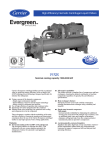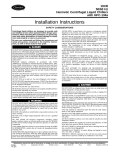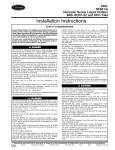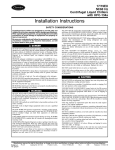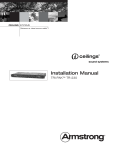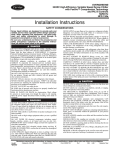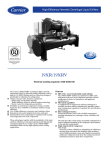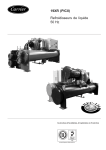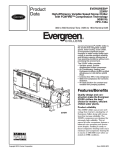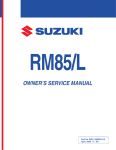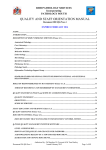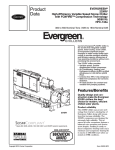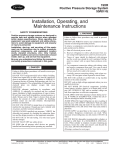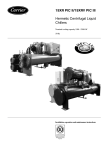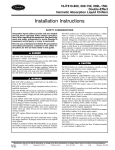Download Carrier 19XR Specifications
Transcript
19XR 50/60 Hz Hermetic Centrifugal Liquid Chillers with HFC-134a Installation Instructions SAFETY CONSIDERATIONS Centrifugal liquid chillers are designed to provide safe and reliable service when operated within design specifications. When operating this equipment, use good judgment and safety precautions to avoid damage to equipment and property or injury to personnel. Be sure you understand and follow the procedures and safety precautions contained in the machine instructions, as well as those listed in this guide. DO NOT VENT refrigerant relief devices within a building. Outlet from rupture disc or relief valve must be vented outdoors in accordance with the latest edition of ANSI/ASHRAE 15 (Safety Code for Mechanical Refrigeration). The accumulation of refrigerant in an enclosed space can displace oxygen and cause asphyxiation. PROVIDE adequate ventilation in accordance with ANSI/ ASHRAE 15, especially for enclosed and low overhead spaces. Inhalation of high concentrations of vapor is harmful and may cause heart irregularities, unconsciousness, or death. Intentional misuse can be fatal. Vapor is heavier than air and reduces the amount of oxygen available for breathing. Product causes eye and skin irritation. Decomposition products are hazardous. DO NOT USE OXYGEN to purge lines or to pressurize a machine for any purpose. Oxygen gas reacts violently with oil, grease, and other common substances. DO NOT USE air to leak test. Use only refrigerant or dry nitrogen. NEVER EXCEED specified test pressures. VERIFY the allowable test pressure by checking the instruction literature and the design pressures on the equipment nameplate. DO NOT VALVE OFF any safety device. BE SURE that all pressure relief devices are properly installed and functioning before operating any machine. DO NOT WELD OR FLAMECUT any refrigerant line or vessel until all refrigerant (liquid and vapor) has been removed from chiller. Traces of vapor should be displaced with dry air or nitrogen and the work area should be well ventilated. Refrigerant in contact with an open flame produces toxic gases. DO NOT USE eyebolts or eyebolt holes to rig machine sections or the entire assembly. DO NOT work on high-voltage equipment unless you are a qualified electrician. DO NOT WORK ON electrical components, including control panels, switches, starters, or oil heater until you are sure ALL POWER IS OFF and no residual voltage can leak from capacitors or solid-state components. LOCK OPEN AND TAG electrical circuits during servicing. IF WORK IS INTERRUPTED, confirm that all circuits are deenergized before resuming work. AVOID SPILLING liquid refrigerant on skin or getting it into the eyes. USE SAFETY GOGGLES. Wash any spills from the skin with soap and water. If liquid refrigerant enters the eyes, IMMEDIATELY FLUSH EYES with water and consult a physician. NEVER APPLY an open flame or live steam to a refrigerant cylinder. Dangerous over pressure can result. When it is necessary to heat refrigerant, use only warm (110 F [43 C]) water. DO NOT REUSE disposable (nonreturnable) cylinders or attempt to refill them. It is DANGEROUS AND ILLEGAL. When cylinder is emptied, evacuate remaining gas pressure, loosen the collar, and unscrew and discard the valve stem. DO NOT INCINERATE. CHECK THE REFRIGERANT TYPE before adding refrigerant to the machine. The introduction of the wrong refrigerant can cause machine damage or malfunction. Operation of this equipment with refrigerants other than those cited herein should comply with ANSI/ASHRAE15 (latest edition). Contact Carrier for further information on use of this machine with other refrigerants. DO NOT ATTEMPT TO REMOVE fittings, covers, etc., while machine is under pressure or while machine is running. Be sure pressure is at 0 psig (0 kPa) before breaking any refrigerant connection. CAREFULLY INSPECT all relief valves, rupture discs, and other relief devices AT LEAST ONCE A YEAR. If machine operates in a corrosive atmosphere, inspect the devices at more frequent intervals. DO NOT ATTEMPT TO REPAIR OR RECONDITION any relief valve when corrosion or build-up of foreign material (rust, dirt, scale, etc.) is found within the valve body or mechanism. Replace the valve. DO NOT install relief devices in series or backwards. USE CARE when working near or in line with a compressed spring. Sudden release of the spring can cause it and objects in its path to act as projectiles. DO NOT STEP on refrigerant lines. Broken lines can whip about and release refrigerant, causing personal injury. DO NOT climb over a machine. Use platform, catwalk, or staging. Follow safe practices when using ladders. USE MECHANICAL EQUIPMENT (crane, hoist, etc.) to lift or move inspection covers or other heavy components. Even if components are light, use mechanical equipment when there is a risk of slipping or losing your balance. BE AWARE that certain automatic start arrangements CAN ENGAGE THE STARTER, TOWER FAN, OR PUMPS. Open the disconnect ahead of the starter, tower fan, and pumps. Shut off the machine or pump before servicing equipment. USE only repaired or replacement parts that meet the code requirements of the original equipment. DO NOT VENT OR DRAIN waterboxes containing industrial brines, liquid, gases, or semisolids without the permission of your process control group. DO NOT LOOSEN waterbox cover bolts until the waterbox has been completely drained. DOUBLE-CHECK that coupling nut wrenches, dial indicators, or other items have been removed before rotating any shafts. DO NOT LOOSEN a packing gland nut before checking that the nut has a positive thread engagement. PERIODICALLY INSPECT all valves, fittings, and piping for corrosion, rust, leaks, or damage. PROVIDE A DRAIN connection in the vent line near each pressure relief device to prevent a build-up of condensate or rain water. Manufacturer reserves the right to discontinue, or change at any time, specifications or designs without notice and without incurring obligations. Book 2 PC 211 Catalog No. 531-951 Printed in U.S.A. Form 19XR-1SI Pg 1 1-96 Replaces: New Tab 5a CONTENTS 1. Inspect for shipping damage while machine is still on shipping conveyance. If machine appears to be damaged or has been torn loose from its anchorage, have it examined by transportation inspectors before removal. Forward claim papers directly to transportation company. Manufacturer is not responsible for any damage incurred in transit. 2. Check all items against shipping list. Immediately notify the nearest Carrier representative if any item is missing. 3. To prevent loss or damage, leave all parts in original packages until beginning installation. All openings are closed with covers or plugs to prevent dirt and debris from entering machine components during shipping. A full operating oil charge is placed in the oil sump before shipment. Page SAFETY CONSIDERATIONS . . . . . . . . . . . . . . . . . . 1 INTRODUCTION . . . . . . . . . . . . . . . . . . . . . . . . . . . . . 2 General . . . . . . . . . . . . . . . . . . . . . . . . . . . . . . . . . . . . . 2 Job Data . . . . . . . . . . . . . . . . . . . . . . . . . . . . . . . . . . . . 2 INSTALLATION . . . . . . . . . . . . . . . . . . . . . . . . . . . . . 2-26 Receiving the Machine . . . . . . . . . . . . . . . . . . . . . . . 2 • INSPECT SHIPMENT • IDENTIFY MACHINE • PROVIDE MACHINE PROTECTION Rigging the Machine . . . . . . . . . . . . . . . . . . . . . . . . . 2 • RIG MACHINE ASSEMBLY • RIG MACHINE COMPONENTS Install Machine Supports . . . . . . . . . . . . . . . . . . . . 12 • INSTALL STANDARD ISOLATION • INSTALL OPTIONAL ISOLATION • INSTALL SPRING ISOLATION Connect Piping . . . . . . . . . . . . . . . . . . . . . . . . . . . . . 14 • INSTALL WATER PIPING TO HEAT EXCHANGERS • INSTALL VENT PIPING TO RELIEF DEVICES Make Electrical Connections . . . . . . . . . . . . . . . . 19 • CONNECT CONTROL INPUTS • CONNECT CONTROL OUTPUTS • CONNECT STARTER • CARRIER COMFORT NETWORK INTERFACE Install Field Insulation . . . . . . . . . . . . . . . . . . . . . . 26 INSTALLATION START-UP REQUEST CHECKLIST . . . . . . . . . . . . . . . . . . . . . . . . CL-1, CL-2 IDENTIFY MACHINE — The machine model number, serial number, and heat exchanger sizes are stamped on machine identification nameplate (Fig. 1 and 2). Check this information against shipping papers and job data. PROVIDE MACHINE PROTECTION — Protect machine and starter from construction dirt and moisture. Keep protective shipping covers in place until machine is ready for installation. If machine is exposed to freezing temperatures after water circuits have been installed, open waterbox drains and remove all water from cooler and condenser. Leave drains open until system is filled. Rigging the Machine — The 19XR machine can be rigged as an entire assembly. It also has flanged connections that allow the compressor, cooler, and condenser sections to be separated and rigged individually. RIG MACHINE ASSEMBLY — See rigging instructions on label attached to machine. Also refer to rigging guide (Fig. 3), physical data in Fig. 4, and Tables 1-5. Lift machine only from the points indicated in rigging guide. Each lifting cable or chain must be capable of supporting the entire weight of the machine. INTRODUCTION General — The 19XR machine is factory assembled, wired, and leak tested. Installation (not by Carrier) consists primarily of establishing water and electrical services to the machine. The rigging, installation, field wiring, field piping, and insulation of waterbox covers are the responsibility of the contractor and/or customer. Carrier has no installation responsibilities for the equipment. Job Data Necessary information consists of: • job contract or specifications • machine location prints • rigging information • piping prints and details • field wiring drawings • starter manufacturer’s installation details • Carrier certified print Lifting machine from points other than those specified may result in serious damage to the unit and personal injury. Rigging equipment and procedures must be adequate for machine weight. See Tables 1-5 for machine weights. NOTE: These weights are broken down into component sections for use when installing the unit in sections. For the complete machine weight, add all component sections and refrigerant charge together. See Tables 1-5 for machine component weights. INSTALLATION IMPORTANT: Make sure that rigging cable is over the rigging bar before lifting. Receiving the Machine INSPECT SHIPMENT Do not open any valves or loosen any connections. The standard 19XR machine is shipped with a full refrigerant charge. Some machines may be shipped with a nitrogen holding charge as an option. 2 Fig. 1 — Model Number Identification 3 FRONT TOP VIEW 1 2 3 4 5 6 7 8 9 10 11 12 13 14 15 16 — — — — — — — — — — — — — — — — Motor Section Discharge Isolation Valve Condensor Safety Relief Valves Condensor Pumpdown Valve (Hidden) Optional Hot Gas Bypass Line (Typical) Condenser Water Nozzles Take-Apart Rabbet-Fit Connector (Upper) Take-Apart Rabbet-Fit Connector (Lower) Cooler Water Nozzles (Typical) Cooler Safety Relief Valve Cooler Pumpdown Valve (Hidden) Machine Identification Nameplate Control Center Refrigerant Charging Valve Compressor Section Auxiliary Power Panel 17 18 19 20 21 22 — — — — — — Unit-Mounted Starter (Optional) Refrigerant Cooling Line Cooler Isolation Valve Hot Gas Bypass Isolation Valve Waterbox Drains Waterbox Vents BOTTOM REAR VIEW Fig. 2 — Typical 19XR Installation 4 COMPRESSOR FRAME SIZE* 3 4 COOLER SIZE MAXIMUM WEIGHT (lb) VESSEL LENGTH DIM. ‘‘A’’ 40-42 45-47 50-52 55-57 50-52 55-57 60-62 65-67 29,700 31,800 31,200 33,200 32,530 34,230 34,950 36,950 128 148 128 148 128 148 128 148 58- 99 68-109 58- 99 68-109 58- 99 68- 29 58- 99 68- 29 ‘‘B’’ 128-89 138-19 128-79 138-19 138-19 138-79 138-19 138-79 *The first digit of the 3-digit compressor code indicates the frame size of the compressor. MACHINE RIGGING GUIDE NOTES: 1. Each cable must be capable of supporting the entire weight of the machine. See chart for maximum weights. 2. Chain lengths shown are typical for 158 lifting height. Some minor adjustments may be required. Fig. 3 — Machine Rigging Guide 5 CHAIN LENGTH ‘‘C’’ ‘‘D’’ 128-89 138-49 138-29 138-89 128-99 138-59 138-39 138-99 128-99 138-49 138-19 148-49 128-99 138-49 138-19 148-49 MOTOR SERVICE CLEARANCE 4'0"- (1219 mm) 3'0" (915 mm) RECOMMENDED OVERHEAD SERVICE CLEARANCE TUBE REMOVAL SPACE FOR EITHER END 12'-31/2" (3747 mm) (SIZE 30-32, 40-42, 50-52, 60-62) 14'-3" (4343 mm) (SIZE 35-37, 45-47, 55-57, 65-67) C 2'-61/8" MIN (362 mm) A B 2' MIN (610 mm) SERVICE AREA HEAT EXCHANGER SIZE 30 35 40 45 50 55 60 65 to to to to to to to to ft-in. 14-07⁄8 15-93⁄8 14-07⁄8 15-93⁄8 14-07⁄8 15-93⁄8 14-07⁄8 15-93⁄8 32 37 42 47 52 57 62 67 A (Length, with Nozzle-in-Head Waterbox) 2-Pass* 1 or 3 Pass† mm ft-in. 4290 14-73⁄8 4811 16-43⁄8 4290 14-77⁄8 4811 16-43⁄8 4290 14-77⁄8 4811 16-43⁄8 4290 14-77⁄8 4811 16-43⁄8 HEAT EXCHANGER SIZE 30 35 40 45 50 55 60 65 FRAME SIZE 3 4 5 6 to to to to to to to to 32 37 42 47 52 57 62 67 1-Pass 10 10 10 10 B (Width) mm 4468 4989 4468 4989 4468 4989 4468 4989 ft-in. 6-43⁄8 6-43⁄8 6-43⁄8 6-43⁄8 6-87⁄8 6-87⁄8 7-0 7-0 C (Height) mm 1941 1941 1941 1941 2055 2055 2123 2123 A (Length, Marine Waterbox — not shown) 2-Pass* 1 or 3 Pass (Cooler Only) ft-in. mm ft-in. mm 4642 16-117⁄8 5179 15- 27⁄8 5166 18- 83⁄8 5700 16-113⁄8 4642 16-117⁄8 5179 15- 27⁄8 5166 18- 83⁄8 5700 16-113⁄8 4642 16-117⁄8 5179 15- 27⁄8 5166 18- 83⁄8 5700 16-113⁄8 4642 16-117⁄8 5179 15- 27⁄8 5166 18- 83⁄8 5700 16-113⁄8 NOZZLE SIZE (in.) (Nominal Pipe Size) Cooler Condenser 2-Pass 3-Pass 1-Pass 2-Pass 8 6 10 8 8 6 10 8 8 6 10 10 10 8 10 10 *Assumes both cooler and condenser nozzles on same end of chiller. †1 or 3 pass length applies if either (or both) cooler or condenser is a 1 or 3 pass design. NOTES: 1. Service access should be provided per American Society of Heating, Refrigeration, and Air Conditioning Engineers (ASHRAE) 15, latest edition, National Fire Protection Association (NFPA) 70, and local safety code. 2. Allow at least 3 ft (915 mm) overhead clearance for service rigging. 3. Certified drawings available upon request. Fig. 4 — 19XR Dimensions 6 3-Pass 6 6 8 8 ft-in. 7-23⁄16 7-23⁄16 7-23⁄16 7-23⁄16 7-23⁄16 7-23⁄16 7-43⁄16 7-43⁄16 mm 2190 2190 2190 2190 2190 2190 2240 2240 Table 1 — 19XR Compressor Weights ENGLISH Total Compressor Weight* (lb) 60 Hz 50 Hz 4658 4745 4684 4770 4709 4841 4736 4867 4750 4882 4805 4897 4873 4897 6043 6089 6069 6155 6147 6193 6155 6282 6205 6343 6295 6397 6343 6799 6397 6909 MOTOR CODE CD CE CL CM CN CP CQ DB DC DD DE DF DG DH DJ Table 2 — 19XR Component Weights SI Total Compressor Weight* (kg) 60 Hz 50 Hz 2113 2152 2125 2164 2136 2196 2148 2208 2155 2214 2180 2221 2210 2221 2741 2762 2753 2792 2788 2809 2792 2850 2815 2877 2855 2902 2877 3084 2902 3134 COMPONENT Suction Elbow Discharge Elbow Control Cabinet* Optional Unit-Mounted Starter† Optional Isolation Valves FRAME 3 COMPRESSOR lb kg 54 24 46 21 30 14 800 363 115 52 FRAME 4 COMPRESSOR lb kg 175 79 157 71 30 14 800 363 115 52 *Included in total cooler weight. †Weight of optional factory-mounted starter is not included and must be added to the heat exchanger weight. *Compressor weight is comprised of compressor, stator, rotor, end bell, suction elbow, and discharge elbow. NOTE: For medium voltage motors (over 600 v), add 490 lb (222 kg). Table 3 — 19XR Heat Exchanger Data ENGLISH CODE 30 31 32 35 36 37 40 41 42 45 46 47 50 51 52 55 56 57 60 61 62 65 66 67 Dry (Rigging) Weight (lb)* Cooler Only Condenser Only 3587 3769 3952 3899 4107 4314 5898 6080 6244 6353 6561 6748 7015 7262 7417 7559 7839 8016 8270 8462 8617 8943 9161 9338 4204 4409 4610 4591 4825 5054 6071 6268 6461 6636 6861 7080 7293 7490 7683 7990 8214 8434 8286 8483 8676 9204 9428 9648 SI Dry (Rigging) Weight (kg)* Machine Charge Refrigerant Weight Cooler Condenser 350 280 420 280 490 280 400 330 480 330 550 330 560 280 630 280 690 280 640 330 720 330 790 330 750 400 840 400 900 400 850 490 960 490 1020 490 960 420 1040 420 1090 420 1100 510 1180 510 1250 510 Water Volume (gal) Cooler Condenser 55 55 64 65 72 74 61 62 70 72 80 83 89 96 97 106 105 114 98 106 108 117 116 127 115 128 126 137 133 146 127 142 139 152 147 162 144 159 153 168 160 177 160 176 169 187 177 197 Cooler Only Condenser Only 1627 1709 1792 1768 1863 1956 2675 2757 2832 2881 2976 3060 3181 3293 3364 3428 3555 3635 3751 3838 3908 4056 4155 4235 1907 2000 2091 2082 2188 2292 2753 2843 2930 3010 3112 3211 3307 3397 3484 3624 3725 3825 3758 3847 3935 4174 4276 4376 Machine Charge Refrigerant Weight Cooler Condenser 159 127 190 127 222 127 181 150 218 150 249 150 254 127 286 127 313 127 290 150 327 150 358 150 340 181 381 181 408 181 385 222 435 222 463 222 435 190 472 190 494 190 499 231 535 231 567 231 *Rigging weights are for standard tubes of standard wall thickness (Turbo-B3 and Spikefin 2, 0.025-in. [0.635 mm] wall). NOTES: 1. Cooler includes the control panel (LID), suction elbow, and 1⁄2 the distribution piping weight. 2. Condenser includes float valve and sump, discharge elbow, and 1⁄2 the distribution piping weight. 3. For special tubes refer to the 19XR Computer Selection Program. 4. All weights for standard 2 pass NIH (nozzle-in-head) design. 7 Water Volume (L) Cooler Condenser 210 210 241 246 271 282 232 233 266 273 301 314 338 365 368 400 396 433 372 403 407 442 438 481 435 483 477 518 502 552 481 536 527 575 557 613 546 601 578 636 604 669 605 668 641 707 671 745 Table 4 — 19XR Additional Data for Marine Waterboxes* HEAT EXCHANGER FRAME, PASS Frame Frame Frame Frame Frame Frame Frame Frame Frame Frame Frame Frame Frame Frame Frame Frame 3, 3, 4, 4, 5, 5, 6, 6, 3, 3, 4, 4, 5, 5, 6, 6, 1 2 1 2 1 2 1 2 1 2 1 2 1 2 1 2 and 3 Pass and 3 Pass and 3 Pass and 3 Pass and 3 Pass and 3 Pass and 3 Pass and 3 Pass Pass Pass Pass Pass Pass Pass Pass Pass Psig 150 150 150 150 150 150 150 150 300 300 300 300 300 300 300 300 ENGLISH Rigging Weight (lb) 730 365 1060 530 1240 620 1500 750 860 430 1210 600 1380 690 1650 825 Water Volume (gal) 84 42 123 61 139 69 162 81 84 42 123 61 139 69 162 81 kPa 1034 1034 1034 1034 1034 1034 1034 1034 2068 2068 2068 2068 2068 2068 2068 2068 SI Rigging Weight (kg) 331 166 481 240 562 281 680 340 390 195 549 272 626 313 748 374 Water Volume (L) 317 159 465 231 526 263 612 306 317 159 465 231 526 263 612 306 *Add to heat exchanger data for total weights or volumes. NOTE: Weight shown is total for cooler and condenser. Cooler and condenser of the same frame size are of equal weight. Table 5 — 19XR Waterbox Cover Weights ENGLISH (lb) HEAT EXCHANGER WATERBOX DESCRIPTION COOLER/CONDENSER NIH, 1 Pass Cover, 150 psig NIH, 2 Pass Cover, 150 psig NIH, 3 Pass Cover, 150 psig NIH/MWB End Cover or MWB 1*, 2, or 3* Pass Cover, 150 psig MWB End Cover or MWB 1*, 2 or 3* Pass Cover, 300 psig FRAME 3 Standard Flanged Nozzles 320 350 320 350 300 340 FRAME 4 Standard Flanged Nozzles 485 521 487 540 504 520 FRAME 5 Standard Flanged Nozzles 616 652 590 663 629 655 FRAME 6 Standard Flanged Nozzles 802 838 770 843 817 843 300 300 379 379 428 428 583 583 400 400 569 569 713 713 833 833 SI (kg) HEAT EXCHANGER WATERBOX DESCRIPTION COOLER/CONDENSER NIH, 1 Pass Cover, 150 psig NIH, 2 Pass Cover, 150 psig NIH, 3 Pass Cover, 150 psig NIH/MWB End Cover or MWB 1*, 2, or 3* Pass Cover, 150 psig MWB End Cover or MWB 1*, 2 or 3* Pass Cover, 300 psig FRAME 3 Standard Flanged Nozzles 145 159 145 159 140 154 FRAME 4 Standard Flanged Nozzles 220 236 221 245 229 236 FRAME 5 Standard Flanged Nozzles 279 296 268 301 285 297 FRAME 6 Standard Flanged Nozzles 364 380 349 382 371 381 136 136 172 172 194 194 264 264 181 181 258 258 323 323 378 378 LEGEND NIH — Nozzle-in-Head MWB — Marine Waterbox *Cooler only. RIG MACHINE COMPONENTS — Refer to instructions below, Fig. 5-8, and Carrier Certified Prints for machine component disassembly. NOTE: If the cooler and condenser vessels must be separated, the heat exchangers should be kept level by placing a support plate under the tube sheets. The support plate will also help to keep the vessels level and aligned when the vessels are bolted back together. NOTE: Wiring must also be disconnected. Label each wire before removal (see Carrier Certified Prints). In order to disconnect the starter from the machine, remove wiring for the oil pump, oil heater, control wiring at the power panel, and the main motor leads at the starter lugs. Remove all transducer and sensor wires at the sensor. Clip all wire ties necessary to pull heat exchangers apart. To separate Cooler and Condenser: 1. Place a support plate under each tube sheet to keep each vessel level (Fig. 5, Item 6). 2. Cut the refrigerant motor cooling line at the location shown (Fig. 5, Item 7). NOTE: Weight for NIH 2-pass cover, 150 psig, are included in heat exchanger weights shown on page 7. IMPORTANT: Only a qualified service technician should perform this operation. Do not attempt to disconnect flanges while the machine is under pressure. Failure to relieve pressure can result in personal injury or damage to the unit. Before rigging the compressor, disconnect all wires entering the power panel. 8 3. Disconnect the motor refrigerant return line (Fig. 5, Item 8). 4. Disconnect the following: a. compressor oil sump temperature sensor cable (Fig. 7, Item 4) b. bearing temperature sensor cable (Fig. 7, Item 2). c. motor temperature sensor cable (Fig. 7, Item 1) d. wires and cable housings that cross from the power panel to the starter and control panel (Fig. 6, Item 2) e. discharge temperature sensor cable (Fig. 7, Item 6) f. compressor oil sump pressure cable (Fig. 7, Item 3) g. compressor oil discharge pressure cable (Fig. 7, Item 5) h. guide vane actuator cable (Fig. 6, Item 1). 5. Disconnect the flared fitting for the oil reclaim line (Fig. 5, Item 3). 6. Unbolt the compressor discharge elbow (Fig. 6, Item 3). 7. Cover all openings. 8. Disconnect motor power cables at the starter lugs (Fig. 5, Item 4). 9. Unbolt the compressor mounting from the cooler (Fig. 5, Item 9). 10. Rig the compressor. 3. Disconnect the compressor discharge elbow at the compressor (Fig. 6, Item 3). 4. Cut the hot gas bypass line at the location shown (Fig. 5, Item 1). 5. Unbolt the cooler liquid feed line at the location shown (Fig. 5, Item 10). 6. Cover all openings. 7. Disconnect all wires and cables that cross from the cooler side of the machine to the condenser side, including: a. temperature sensor cable at the waterbox (Fig. 8, Item 1) b. condenser transducer cable at the transducer (Fig. 6, Item 4) c. motor power wires at the starter (Fig. 5, Item 4) d. wires and cable housings at the power panel that cross from the starter to the power panel (Fig. 6, Item 2). 8. Disconnect the rabbet-fit connectors on the tube sheets (Fig. 5, Item 5). 9. Rig the vessels apart. To Separate the Compressor from the Cooler: 1. Unbolt the compressor suction elbow at the cooler flange (Fig. 5, Item 2). 2. Cut the refrigerant motor cooling line at the location shown (Fig. 5, Item 7). 1 2 3 4 5 — — — — — Optional Hot Gas Bypass (Cut) Compressor Suction Elbow (Unbolt) Oil Reclaim Line (Unbolt) Starter Connector (Unbolt) Vessel Connectors (Unbolt) 6 7 8 9 10 — — — — — Tube Sheet Refrigerant Motor Cooling Line (Cut) Motor Drain (Unbolt) Compressor Mounting (Unbolt) Cooler Liquid Feed Line (Unbolt) Fig. 5 — Cooler, Side View 9 3 — Compressor Discharge Elbow Joints 4 — Condenser Transducer Cable 1 — Guide Vane Actuator Cable 2 — Power Panel to Starter Cables (Oil Pump Power, Control Power, and Communication) Fig. 6 — 19XR Chiller Top View 4 — Compressor Oil Sump Temperature Sensor Cable 5 — Compressor Oil Discharge Pressure Cable 6 — Discharge Temperature Sensor Cable 1 — Motor Temperature Sensor Cable 2 — Bearing Temperature Sensor Cable Connection (Inside Box) 3 — Compressor Oil Sump Pressure Cable Fig. 7 — Compressor Detail 10 1 — Water Temperature Sensor Cables Fig. 8 — Chiller End View 11 INSTALL ACCESSORY ISOLATION (if required) — Uneven floors or other considerations may dictate the use of accessory soleplates (supplied by Carrier for field installation) and leveling pads. Refer to Fig. 9 and 11. Level machine by using jacking screws in isolation soleplates. Use a level at least 24-in. (600 mm) long. For adequate and long lasting machine support, proper grout selection and placement is essential. Carrier recommends that only pre-mixed, epoxy type, non-shrinking grout be used for machine installation. Follow manufacturer’s instructions in applying grout. 1. Check machine location prints for required grout thickness. 2. Carefully wax jacking screws for easy removal from grout. 3. Grout must extend above the base of the soleplate and there must be no voids in grout beneath the plates. 4. Allow grout to set and harden, per manufacturer’s instructions, before starting machine. 5. Remove jacking screws from leveling pads after grout has hardened. To Rig Compressor NOTE: The motor end of the 19XR compressor is heavy and will tip backwards unless these directions are followed: 1. Cut two 4 in. × 6 in. wooden beams to the same length as the compressor. 2. Drill holes into the beams and bolt them to the base of the compressor. Additional Notes 1. Use silicon grease on new O-rings when refitting. 2. Use gasket sealant on new gaskets when refitting. 3. Cooler and condenser vessels may be rigged vertically. Rigging should be fixed to all 4 corners of the tube sheet. Install Machine Supports INSTALL STANDARD ISOLATION — Figures 9 and 10 show the position of support plates and shear flex pads, which together form the standard machine support system. DIMENSIONS (ft-in.) A B 12-103⁄4 5-43⁄4 14- 71⁄4 5-43⁄4 3 12-10 ⁄4 6-0 14- 71⁄4 6-0 6-51⁄2 12-103⁄4 14- 71⁄4 6-51⁄2 3 12-10 ⁄4 6-91⁄2 14- 71⁄4 6-91⁄2 HEAT EXCHANGER SIZE 30-32 35-37 40-42 45-47 50-52 55-57 60-62 65-67 Fig. 9 — 19XR Machine Footprint 12 INSTALL SPRING ISOLATION — Spring isolation may be purchased as an accessory from Carrier for field installation. It may also be field supplied and installed. Spring isolators may be placed directly under machine support plates or located under machine soleplates. See Fig. 12. Consult job data for specific arrangement. Low profile spring isolation assemblies can be field supplied to keep the machine at a convenient working height. Obtain specific details on spring mounting and machine weight distribution from job data. Also, check job data for methods to support and isolate pipes that are attached to spring isolated machines. NOTES: 1. Dimensions in ( ) are in millimeters. 2. Isolation package includes 4 shear flex pads. VIEW Y-Y Fig. 10 — Standard Isolation ACCESSORY SOLEPLATE DETAIL VIEW X-X LEGEND HRS — Hot Rolled Steel 3. Jacking screws to be removed after grout has set. 4. Thickness of grout will vary, depending on the amount necessary to level chiller. Use only pre-mixed non-shrinking grout, Celcote HT-648 or Master Builders 636, 08-11⁄29 (38.1) to 08-21⁄49 (57) thick. NOTES: 1. Dimensions in ( ) are in millimeters. 2. Accessory (Carrier supplied, field installed) soleplate package includes 4 soleplates, 16 jacking screws and leveling pads. Fig. 11 — Accessory Isolation NOTE: The accessory spring isolators are supplied by Carrier for installation in the field. Fig. 12 — 19XR Accessory Spring Isolation (Shown with Accessory Soleplates) 13 2. Provide openings in water piping for required pressure gages and thermometers. For thorough mixing and temperature stabilization, wells in the leaving water pipe should extend inside pipe at least 2 in. (50 mm). 3. Install air vents at all high points in piping to remove air and prevent water hammer. 4. Install pipe hangers where needed. Make sure no weight or stress is placed on waterbox nozzles or flanges. 5. Water flow direction must be as specified in Fig. 14. NOTE: Entering water is always the lower of the 2 nozzles. Leaving water is always the upper nozzle for cooler or condenser. 6. Water flow switches must be of vapor-tight construction and must be installed on top of pipe in a horizontal run and at least 5 pipe diameters from any bend. 7. Install waterbox vent and drain piping in accordance with individual job data. All connections are 3⁄4-in. FPT. 8. Install waterbox drain plugs in the unused waterbox drains and vent openings. 9. Install optional pumpout system or pumpout system and storage tank as shown in Fig. 15-18. Connect Piping INSTALL WATER PIPING TO HEAT EXCHANGERS — Install piping using job data, piping drawings, and procedures outlined below. A typical piping installation is shown in Fig. 13. Factory-supplied insulation is not flammable but can be damaged by welding sparks and open flame. Protect insulation with a wet canvas cover. Remove chilled and condenser water sensors before welding connecting piping to water nozzles. Refer to Fig. 2. Replace sensors after welding is complete. 1. Offset pipe flanges to permit removal of waterbox cover for maintenance and to provide clearance for pipe cleaning. No flanges are necessary with marine waterbox option; however, water piping should not cross in front of the waterbox or access will be blocked. * * LEGEND COM — Common N.O. — Normally Open *Do not tap connections after shutoff valve. Fig. 13 — Typical Nozzle Piping 14 19XR NOZZLE ARRANGEMENTS NOZZLE-IN HEAD WATERBOXES DRIVE END COMPRESSOR END FRAME 3 DRIVE END COMPRESSOR END FRAME 4, 5 AND 6 NOZZLE ARRANGEMENT CODES PASS 1 2 3 In 8 5 7 4 7 4 COOLER WATERBOXES Arrangement Out Code* 5 A 8 B 9 C 6 D 6 E 9 F PASS In 11 2 10 1 10 1 1 2 3 CONDENSER WATERBOXES Arrangement Out Code* 2 P 11 Q 12 R 3 S 3 T 12 U *Refer to Carrier certified dimensional prints for arrangement codes specific to each machine. MARINE WATERBOXES DRIVE END COMPRESSOR END NOZZLE ARRANGEMENT CODES PASS 1 2 3 COOLER WATERBOXES In Out Arrangement Code 8 5 A 5 8 B 7 9 C 4 6 D 7 6 E 4 9 F WATERBOX NOZZLE SIZES CONDENSER WATERBOXES In Out Arrangement Code — — — — — — 10 12 R 1 3 S — — — — — — FRAME 3 4 5 6 PASS 1 2 3 1 2 3 1 2 3 1 2 3 Fig. 14 — Piping Flow Data 15 NOMINAL PIPE SIZE (in.) Cooler Condenser 10 10 8 8 6 6 10 10 8 8 6 6 10 10 8 10 6 8 10 10 10 10 8 8 ACTUAL PIPE ID (in.) Cooler Condenser 10.020 10.020 7.981 7.981 6.065 6.065 10.020 10.020 7.981 7.981 6.065 6.065 10.020 10.020 7.981 10.020 6.065 7.981 10.020 10.020 10.020 10.020 7.981 7.961 DIMENSIONS ENGLISH (ft-in.) TANK A SIZE 0428 10- 5 0452 14-111⁄4 B C D E F G 9-10 4-9 2-4 ⁄ 1-2 ⁄ 3-1 ⁄ 4-11 14- 41⁄2 5-07⁄8 2-81⁄2 1-41⁄4 3-47⁄16 7- 21⁄4 34 38 3 16 H J 3-8 ⁄ 4-0 3- 8 3-117⁄8 18 K L M N P R S 2-9 ⁄ 3-2 0-3 ⁄ 4-8 ⁄ 1-7 ⁄ 1-7 ⁄ 3-7 ⁄ 3-15⁄16 3-57⁄8 0-33⁄8 7-11⁄2 1-83⁄4 1-79⁄16 3-8 7 16 12 34 78 5 16 34 T 5-01⁄4 5-01⁄2 SI (mm) TANK SIZE 0428 0452 A B C D E F G H J K L M N P R S T 3175 4553 2997 4382 1448 1546 730 826 365 413 945 1027 1499 2191 1121 1219 1118 1216 849 948 965 1064 89 86 1442 2172 505 528 491 497 1111 1118 1530 1537 NOTES: 1. 2. 3. 4. 5. Denotes center of gravity. Dimensions in ( ) are in millimeters. The weights and center of gravity values given are for an empty storage tank. For additional information on the pumpout unit, see certified drawings. The available conduit knockout sizes are: QTY 1 1 1 1 TRADE SIZE 1⁄29 3⁄49 19 11⁄49 LOCATION top bottom middle middle Fig. 15 — Optional Pumpout Unit and Storage Tank 16 RATED DRY WEIGHT AND REFRIGERANT CAPACITY ENGLISH (lb) TANK SIZE TANK OD (in.) 0428 0452 24.00 27.25 DRY WEIGHT* (lb) 2155 3181 MAXIMUM REFRIGERANT CAPACITY (lb) ASHRAE 15 ARI 495 2025 3880 1810 3465 SI (kg) TANK SIZE TANK OD (mm) 0428 0452 610 592 DRY WEIGHT* (kg) 978 1443 MAXIMUM REFRIGERANT CAPACITY (kg) ASHRAE 15 ARI 495 928 1760 822 1572 LEGEND ARI — Air Conditioning and Refrigeration Institute ASHRAE — American Society of Heating, Refrigeration, and Air Conditioning Engineers OD — Outside Diameter *The above dry weight includes the pumpout condensing unit weight of 210 lbs (95 kg). Fig. 15 — Optional Pumpout Unit and Storage Tank (cont) 17 Fig. 16 — Optional Pumpout System Piping Schematic with Storage Tank Fig. 17 — Optional Pumpout System Piping Schematic without Storage Tank 18 OIL RETURN LINE CONNECTION tubing or piping near the device is essential on springisolated machines. 4. Cover the outdoor vent with a rain cap and place a condensation drain at the low point in the vent piping to prevent water build-up on the atmospheric side of the relief device. DISCHARGE SERVICE VALVE SUCTION SERVICE VALVE Table 6 — Relief Device Locations RELIEF VALVE OUTLET SIZE 1-in. NPT FEMALE CONNECTOR 1-in.NPT FEMALE CONNECTOR 1-in. NPT FEMALE CONNECTOR OIL SIGHT GLASS RELIEF VALVE CONDENSER WATER CONNECTION LOCATION QUANTITY Cooler 1 Condenser 2 Optional Storage Tank 2 Make Electrical Connections — Field wiring must be installed in accordance with job wiring diagrams and all applicable electrical codes. COMPRESSOR MOUNTING SPRINGS REFRIGERANT INLET VALVE Fig. 18 — Pumpout Unit Do not run 120-v wiring into the control cabinet. The control cabinet should only be used for additional extralow voltage wiring (50 v maximum). INSTALL VENT PIPING TO RELIEF DEVICES — The 19XR chiller is factory equipped with relief devices on the cooler and condenser shells. Refer to Fig. 19 and Table 6 for size and location of relief devices. Vent relief devices to the outdoors in accordance with ANSI/ASHRAE 15 (latest edition) Safety Code for Mechanical Refrigeration and all other applicable codes. Wiring diagrams in this publication (Fig. 20-27) are for reference only and are not intended for use during actual installation; follow job specific wiring diagrams. Do not attempt to start compressor or oil pump (even for a rotation check) or apply test voltage of any kind while machine is under dehydration vacuum. Motor insulation breakdown and serious damage may result. Refrigerant discharged into confined spaces can displace oxygen and cause asphyxiation. 1. If relief devices are manifolded, the cross-sectional area of the relief pipe must at least equal the sum of the areas required for individual relief pipes. 2. Provide a pipe plug near outlet side of each relief device for leak testing. Provide pipe fittings that allow vent piping to be disconnected periodically for inspection of valve mechanism. 3. Piping to relief devices must not apply stress to the device. Adequately support piping. A length of flexible CONNECT CONTROL INPUTS — Connect the control input wiring from the chilled and condenser water flow switches to the starter terminal strip. Wiring may also be specified for a spare safety switch, and a remote start/stop contact can be wired to the starter terminal strip. Additional spare sensors and Carrier Comfort Network modules may be specified as well. These are wired to the machine control panel as indicated in Fig. 20 and 21. Fig. 19 — Relief Valve Locations 19 Fig. 20 — Carrier Comfort Network Communication Bus Wiring LEGEND Factory Wiring Field Wiring *Field supplied terminal strip must be located in control panel. Fig. 21 — COMM1 CCN Communication Wiring For Multiple Chillers (Typical) 20 CONNECT CONTROL OUTPUTS — Connect auxiliary equipment, chilled and condenser water pumps, and spare alarms as required and indicated on job wiring drawings. CONNECT STARTER — The 19XR is available with either a unit-mounted, factory-installed starter or a free-standing, field-installed starter (Fig. 22 and 23). Unit Mounted, Factory-Installed Starter— Attach power leads by connecting them from inside the starter cabinet to the line side circuit breaker terminals. See Fig. 22 and 24. Machines with electro-mechanical starters (wye-delta) will have a top hat shipped with the machine if the RLA is greater than 432 amps. The top hat is shipped in the knocked-down position and must be assembled and installed on top of the starter cabinet, over the line side circuit breaker. During assembly, remove the access plate and use it as the cover piece of the top hat. The top hat provides additional wire bending space to attach line side power leads to the circuit breaker within the starter. The solid-state starter does not require a top hat. IMPORTANT: Be sure to ground the power circuit in accordance with the National Electrical Code (NEC), applicable local codes, and job wiring diagrams. Also, make sure correct phasing is observed for proper rotation. 3 8 7 Piping Control Wiring Power Wiring LEGEND 1 2 3 4 5 6 7 8 9 10 11 — — — — — — — — — — — Disconnect Unit Mounted Starter Control Cabinet Power Panel Vents Pressure Gages Chilled Water Pump Condenser Water Pump Chilled Water Pump Starter Condensing Water Pump Starter Cooling Tower Fan Starter NOTES: 1. Wiring and piping shown are for general point-of-connection only and are not intended to show details for a specific installation. Certified field wiring and dimensional diagrams are available on request. 2. All wiring must comply with applicable codes. 3. Refer to Carrier System Design Manual for details regarding piping techniques. 4. Wiring not shown for optional devices such as: • remote start-stop • remote alarm • optional safety device • 4 to 20 mA resets • optional remote sensors Fig. 22 — 19XR with Optional Unit-Mounted Starter 21 1. Insulate each terminal by wrapping with one layer of insulation putty. 2. Overwrap putty with 4 layers of vinyl tape. High Voltage Units — High-voltage units require special terminal preparation. Follow local electrical codes for highvoltage installation. Vinyl tape is not acceptable; a high voltage terminal method must be used. Connect Power Wires to Oil Pump Starter — See Fig. 26. Connect power wires to oil pump starter mounted in machine power panel. Use separate fused disconnect or circuit breaker as shown on job wiring diagrams and Fig. 25. Check that power supply voltage agrees with oil pump voltage. Follow correct phasing for proper motor rotation. Freestanding, Field-Installed Starter — Assemble and install compressor terminal box in desired orientation, and cut necessary conduit openings in conduit support plates. See Fig. 23 and 25. Attach power leads to compressor terminals in accordance with job wiring drawings, observing caution label in terminal box. Use only copper conductors. The motor must be grounded in accordance with NEC (National Electrical Code), applicable local codes, and job wiring diagrams. Installer is responsible for any damage caused by improper wiring between starter and compressor motor. IMPORTANT: Do not insulate terminals until wiring arrangement has been checked and approved by Carrier start-up personnel. Also, make sure correct phasing is followed for proper motor rotation. Insulate Motor Terminals and Lead Wire Ends — Insulate compressor motor terminals, lead wire ends, and electrical wires to prevent moisture condensation and electrical arcing. For low-voltage units (up to 600 v), obtain insulation material from machine shipping package consisting of 3 rolls of insulation putty and one roll of vinyl tape. Do not punch holes or drill into the top surface of the power panel. Knockouts are provided in the bottom of the power panel for wiring connections. Piping Control Wiring Power Wiring 1 2 3 4 5 6 7 8 9 10 11 12 13 14 — — — — — — — — — — — — — — LEGEND Disconnect Freestanding Compressor Motor Starter Compressor Motor Terminal Box Chiller Power Panel Control Cabinet Vents Pressure Gages Chilled Water Pump Condenser Water Pump Chilled Water Pump Starter Condensing Water Pump Starter Cooling Tower Fan Starter Disconnect Oil Pump Disconnect (see Note 5) NOTES: 1. Wiring and piping shown are for general point-of-connection only and are not intended to show details for a specific installation. Certified field wiring and dimensional diagrams are available on request. 2. All wiring must comply with applicable codes. 3. Refer to Carrier System Design Manual for details regarding piping techniques. 4. Wiring not shown for optional devices such as: • remote start-stop • remote alarm • optional safety device • 4 to 20 mA resets • optional remote sensors 5. Oil pump disconnect may be located within the enclosure of Item 2 — Freestanding Compressor Motor Starter. Fig. 23 — 19XR with Freestanding Starter 22 AWG NO NC PR RLA ST TB — — — — — — — LEGEND American Wire Gage Normally Open Normally Closed Pilot Relay Rated Load Amps Shunt Trip Terminal Block Required Power Wiring Required Control Wiring Options Wiring fan motors must be provided to assure machine protection. If primary pump and tower fan motor are controlled by other means, also provide a parallel means for control by Carrier. Do not use starter control transformer as the power source for pilot relay loads. NOTES: I. GENERAL 1.0 Starters shall be designed and manufactured in accordance with Carrier Engineering Requirement Z-375. 1.1 All field-supplied conductors, devices, field-installation wiring, and termination of conductors and devices must be in compliance with all applicable codes and job specifications. 1.2 The routing of field-installed conduit and conductors and the location of field-installed devices must not interfere with equipment access or the reading, adjusting, or servicing of any component. 1.3 Equipment, installation, and all starting and control devices must comply with details in equipment submittal drawings and literature. 1.4 Contacts and switches are shown in the position they would assume with the circuit deenergized and the chiller shut down. 1.5 WARNING — Do not use aluminum conductors. 1.6 Installer is responsible for any damage caused by improper wiring between starter and machine. 3.4 Do not route control wiring carrying 30 v or less within a conduit which has wires carrying 50 v or higher or alongside wires carrying 50 v or higher. 3.5 Voltage selector switch in machine power panel is factory set for 115 v control power source. When 230 v control power source is used, set switch to 230 v position. 3.6 Control wiring cables between starter and power panel must be shielded with minimum rating of 600 v, 80 C. Ground shield at starter. 3.7 If optional oil pump circuit breaker is not supplied within the starter enclosure as shown, it must be located within sight of the machine with wiring routed to suit. IV. POWER WIRING BETWEEN STARTER AND COMPRESSOR MOTOR 4.0 Low voltage (600 v or less) compressor motors have (6) 3⁄4 in. terminal studs (lead connectors not supplied by Carrier). Either 3 or 6 leads must be run between compressor motor and starter, depending on type of motor starter employed. If only 3 leads are required, jumper motor terminals as follows: 1 to 6, 2 to 4, 3 to 5. Center to center distance between terminals is 215⁄16 inches. Compressor motor starter must have nameplate stamped as conforming with Carrier requirement Z-375. 4.1 When more than one conduit is used to run conductors from starter to compressor motor terminal box, one conductor from each phase must be in each conduit to prevent excessive heating. (e.g., conductors to motor terminals 1, 2 & 3 in one conduit, and those to 4, 5 & 6 in another.) 4.2 Compressor motor power connections can be made through top, top rear, or sides of compressor motor terminal box using holes cut by contractor to suit conduit. Flexible conduit should be used for the last few feet to the terminal box for unit vibration isolation. Use of stress cones or 12 conductors larger than 500 MCM may require an oversize (special) motor terminal box (not supplied by Carrier). Lead connections between 3-phase motors and their starters must not be insulated until Carrier personnel have checked compressor and oil pump rotations. 4.3 Compressor motor frame to be grounded in accordance with the National Electrical Code (NFPA-70) and applicable codes. Means for grounding compressor motor is a pressure connector for #4 to 500 MCM wire, supplied and located in the back lower left side corner of the compressor motor terminal box. 4.4 Do not allow motor terminals to support weight of wire cables. Use cable supports and strain reliefs as required. 4.5 Use backup wrench when tightening lead connectors to motor terminal studs. Torque to 45 lb-ft max. II. POWER WIRING TO STARTER 2.0 Power conductor rating must meet minimum unit nameplate voltage and compressor motor RLA. When (3) conductors are used: Minimum ampacity per conductor = 1.25 x compressor RLA When (6) conductors are used: Minimum ampacity per conductor = 0.721 x compressor RLA 2.1 Lug adapters may be required if installation conditions dictate that conductors be sized beyond the minimum ampacity required. Contact starter supplier for lug information. 2.2 Compressor motor and controls must be grounded by using equipment grounding lugs provided inside starter enclosure. III. CONTROL WIRING 3.0 Field supplied control conductors to be at least 18 AWG or larger. 3.1 Chilled water and condenser water flow switch contacts, optional remote start device contacts, and optional spare safety device contacts must have 24 vdc rating. Max current is 60 ma; nominal current is 10 ma. Switches with gold plated bifurcated contacts are recommended. 3.2 Remove jumper wire between 12A and 12B before connecting auxiliary safeties between these terminals. 3.3 Pilot relays can control cooler and condenser pump and tower fan motor contactor coil loads rated 10 amps at 115 vac up to 3 amps at 600 vac. Control wiring required for Carrier to start pumps and tower Fig. 24 — 19XR Typical Field Wiring with Optional Unit-Mounted Starter 23 LEGEND AWG — American Wire Gage RLA — Rated Load Amps SMM — Starter Management Module Required Power Wiring Required Control Wiring Options Wiring 3.4 Do not route control wiring carrying 30 v or less within a conduit which NOTES: has wires carrying 50 v or higher or alongside wires carrying 50 v or I. GENERAL higher. 1.0 Starters shall be designed and manufactured in accordance with 3.5 Voltage selector switch in machine power panel is factory set for Carrier Engineering Requirement Z-375. 115 v control power source. When 230 v control power source is used, 1.1 All field-supplied conductors, devices, field-installation wiring, and terset switch to 230 v position. mination of conductors and devices must be in compliance with all ap3.6 Control wiring cables between starter and power panel must be shielded plicable codes and job specifications. with minimum rating of 600 v, 80 C. Ground shield at starter. 1.2 The routing of field-installed conduit and conductors and the location 3.7 If optional oil pump circuit breaker is not supplied within the starter enof field-installed devices must not interfere with equipment access or closure as shown, it must be located within sight of the machine with the reading, adjusting, or servicing of any component. wiring routed to suit. 1.3 Equipment, installation, and all starting and control devices must com3.8 Voltage to terminals LL1 and LL2 comes from a control transformer in ply with details in equipment submittal drawings and literature. a starter built to Carrier specifications. Do not connect an outside source 1.4 Contacts and switches are shown in the position they would assume of control power to the compressor motor starter (terminals LL1 and with the circuit deenergized and the chiller shut down. LL2). An outside power source will produce dangerous voltage at the 1.5 WARNING — Do not use aluminum conductors. line side of the starter. 1.6 Installer is responsible for any damage caused by improper wiring beIV. POWER WIRING BETWEEN STARTER AND COMPRESSOR MOTOR tween starter and machine. 4.0 Low voltage (600 v or less) compressor motors have (6) 3⁄4 in. terminal II. POWER WIRING TO STARTER studs (lead connectors not supplied by Carrier). Either 3 or 6 leads 2.0 Power conductor rating must meet minimum unit nameplate voltage must be run between compressor motor and starter, depending on type and compressor motor RLA. of motor starter employed. If only 3 leads are required, jumper motor terminals as follows: 1 to 6, 2 to 4, 3 to 5. Center to center distance When (3) conductors are used: between terminals is 215⁄16 inches. Compressor motor starter must have Minimum ampacity per conductor = 1.25 x compressor RLA nameplate stamped as conforming with Carrier requirement Z-375. When (6) conductors are used: 4.1 When more than one conduit is used to run conductors from starter to Minimum ampacity per conductor = 0.721 x compressor RLA compressor motor terminal box, one conductor from each phase must 2.1 Lug adapters may be required if installation conditions dictate that conbe in each conduit to prevent excessive heating. (e.g., conductors to ductors be sized beyond the minimum ampacity required. Contact starter motor terminals 1, 2 & 3 in one conduit, and those to 4, 5 & 6 in supplier for lug information. another.) 2.2 Compressor motor and controls must be grounded by using equip4.2 Compressor motor power connections can be made through top, top ment grounding lugs provided inside starter enclosure. rear, or sides of compressor motor terminal box using holes cut by contractor to suit conduit. Flexible conduit should be used for the last few III. CONTROL WIRING feet to the terminal box for unit vibration isolation. Use of stress cones 3.0 Field supplied control conductors to be at least 18 AWG or larger. or 12 conductors larger than 500 MCM may require an oversize (spe3.1 Chilled water and condenser water flow switch contacts, optional recial) motor terminal box (not supplied by Carrier). Lead connections mote start device contacts, and optional spare safety device contacts between 3-phase motors and their starters must not be insulated until must have 24 vdc rating. Max current is 60 ma; nominal current is Carrier personnel have checked compressor and oil pump rotations. 10 ma. Switches with gold plated bifurcated contacts are recom4.3 Compressor motor frame to be grounded in accordance with the Namended. tional Electrical Code (NFPA-70) and applicable codes. Means for ground3.2 Remove jumper wire between 12A and 12B before connecting auxiling compressor motor is a pressure connector for #4 to 500 MCM wire, iary safeties between these terminals. supplied and located in the back lower left side corner of the compres3.3 Pilot relays can control cooler and condenser pump and tower fan mosor motor terminal box. tor contactor coil loads rated 10 amps at 115 vac up to 3 amps at 4.4 Do not allow motor terminals to support weight of wire cables. Use cable 600 vac. Control wiring required for Carrier to start pumps and towersupports and strain reliefs as required. fan motors must be provided to assure machine protection. If primary 4.5 Use backup wrench when tightening lead connectors to motor terminal pump and tower fan motor are controlled by other means, also provide studs. Torque to 45 lb-ft max. a parallel means for control by Carrier. Do not use starter control transformer as the power source for pilot relay loads. Fig. 25 — 19XR Typical Field Wiring with Free-Standing Starter 24 NOTE: Conductors and drain wire must be 20 AWG (American Wire Gage) minimum stranded, tinned copper. Individual conductors must be insulated with PVC, PVC/ nylon, vinyl, Teflon, or polyethylene. An aluminum/polyester 100% foil shield and an outer jacket of PVC, PVC/nylon, chrome vinyl, or Teflon with a minimum operating temperature range of −4 F to 140 F (−20 C to 60 C) is required. See table below for cables that meet the requirements. Connect Power Wires to Oil Heater Contactor — Connect control power wiring between the oil heater contactor terminals (Fig. 27) and terminals LL1 and LL2 on the field wiring strip in the compressor motor starter. Refer to Fig. 27 and wiring label on the machine power panel. Voltage to terminals LL1 and LL2 comes from a control transformer in a starter built to Carrier specifications. Do not connect an outside source of control power to the compressor motor starter (terminals LL1 and LL2). An outside power source will produce dangerous voltage at the line side of the starter, because supplying voltage at the transfomer secondary terminals produces input level voltage at the transformer primary terminals. MANUFACTURER Alpha American Belden Columbia CABLE NO. 2413 or 5463 A22503 8772 02525 When connecting the CCN communication bus to a system element, a color code system for the entire network is recommended to simplify installation and checkout. The following color code is recommended: Connect Wiring from Starter to Power Panel — Connect control wiring from main motor starter to the machine power panel. All control wiring must use shielded cable. Also, connect the communications cable. Refer to the job wiring diagrams for cable type and cable number. Make sure the control circuit is grounded in accordance with applicable electrical codes and instructions on machine control wiring label. SIGNAL TYPE + Ground − CCN BUS CONDUCTOR INSULATION COLOR Red White Black COMM1 PLUG PIN NO. 1 2 3 If a cable with a different color scheme is selected, a similar color code should be adopted for the entire network. At each system element, the shields of its communication bus cables must be tied together. If the communication bus is entirely within one building, the resulting continuous shield must be connected to ground at only one single point. See Fig. 21. If the communication bus cable exits from one building and enters another, the shields must be connected to ground at the lightening suppressor in each building where the cable enters or exits the building (one point only). To connect the 19XR chiller to the network, proceed as follows (Fig. 21): 1. Cut power to the PIC control panel. 2. Remove the COMM1 plug from the processor module. 3. Cut a CCN wire and strip the ends of the RED, WHITE, and BLACK conductors. 4. Using a wirenut, connect the drain wires together. 5. Insert and secure the RED wire to Terminal 1 of the COMM1 plug. 6. Insert and secure the WHITE wire to Terminal 2 of the COMM1 plug. 7. Insert and secure the BLACK wire to Terminal 3 of the COMM1 plug. 8. Mount a terminal strip in a convenient location. 9. Connect the opposite ends of each conductor to separate terminals on the terminal strip. 10. Cut another CCN wire and strip the ends of the conductors. 11. Connect the RED wire to the matching location on the terminal strip. 12. Connect the WHITE wire to the matching location on the terminal strip. 13. Connect the BLACK wire to the matching location on the terminal strip. LEGEND Factory Wiring Field Wiring Oil Pump Terminal Power Panel Component Terminal Fig. 26 — Oil Pump Wiring LEGEND Field Wiring Power Panel Component Terminal NOTE: The voltage selector switch in the machine power panel is factory set for 115 v control power source. When a 230 v control power source is used, set the voltage selector switch at 230 v. Fig. 27 — Oil Heater and Control Power Wiring CARRIER COMFORT NETWORK INTERFACE — The Carrier Comfort Network (CCN) communication bus wiring is supplied and installed by the electrical contractor. It consists of shielded, 3-conductor cable with drain wire. The system elements are connected to the communication bus in a daisy chain arrangement. The positive pin of each system element communication connector must be wired to the positive pins of the system element on either side of it. The negative pins must be wired to the negative pins. The signal ground pins must be wired to the signal ground pins. See Fig. 20 for location of the CCN network connector (COMM1) on the processor module. 25 Install Field Insulation Protect insulation from weld heat damage and weld splatter. Cover with wet canvas cover during water piping installation. When installing insulation at the job site, insulate the following components: • compressor motor • cooler shell • cooler tube sheets • suction piping • motor cooling drain • oil reclaim piping • oil cooler refrigerant side tubing • refrigerant liquid line to cooler NOTE: Insulation of the waterbox covers is applied only at the jobsite by the contractor. When insulating the covers, make sure there is access for removal of waterbox covers for servicing (Fig. 28). Fig. 28 — 19XR Insulation Area Copyright 1996 Carrier Corporation Manufacturer reserves the right to discontinue, or change at any time, specifications or designs without notice and without incurring obligations. Book 2 PC 211 Catalog No. 531-951 Printed in U.S.A. Form 19XR-1SI Pg 26 1-96 Replaces: New Tab 5a INSTALLATION START-UP REQUEST CHECKLIST Machine Model Number: 19XR Serial Number: To: Date Project Name Attn: Carrier Job Number The following information provides the status of the chiller installation. YES/NO (N/A) 1. The machine is level. 2. The machine components are installed and connected in accordance with the installation instructions. 3. The isolation package and grouting (if necessary) are installed. 4. The relief valves are piped to the atmosphere. 5. All piping is installed and supported. Direction of flow is indicated in accordance with the installation instructions and job prints. a. Chilled water piping b. Condenser water piping c. Waterbox drain piping d. Pumpout unit condenser piping (if installed) e. Other 6. Gages are installed as called for on the job prints required to establish design flow for the cooler and condenser. a. Water pressure gages IN and OUT b. Water temperature gages IN and OUT 7. The machine’s starter wiring is complete. The wiring is installed per installation instructions and certified prints. a. Power wiring to compressor motor. (Motor leads will not be taped until the Carrier technician megger tests the motor.) b. Oil pump wiring c. Oil heater/control wiring d. Other 8. The motor starter has not been supplied by Carrier. It has been installed according to the manufacturer’s instructions. 9. The motor starter has not been supplied by Carrier and it has been checked for proper operation. COMMENTS: CL-1 DATE TO BE COMPLETED DATE TO BE COMPLETED 1. The cooling tower fan has been checked for blade pitch and proper operation. 2. The chilled water and condenser water lines have been: a. Filled b. Tested c. Flushed d. Vented e. Strainers cleaned 3. The chilled water and condenser water pumps have been checked for proper rotation and flow. 4. The following cooling load will be available for start-up: a. 25% b. 50% c. 75% d. 100% 5. The refrigerant charge is at the machine. 6. Services such as electrical power and control air will be available at start-up. 7. The electrical and mechanical representatives will be available to assist in commissioning the machine. 8. The customer’s operators will be available to receive instructions for proper operation of the chiller after start-up. Concerns about the installation/request for additional assistance: I am aware that the start-up time for a Carrier chiller can take between 2 and 6 days depending on the model of the machine and the options and accessories used with it. Your contact at the job site will be Phone number Beeper number Fax number In accordance with our contract, we hereby request the services of your technician to render start-up services per contract terms for this job on (Date). I understand that the technician’s time will be charged as extra services due to correcting items in this checklist that are incomplete. Signature of Purchaser Signature of Job Site Supervisor Copyright 1996 Carrier Corporation Manufacturer reserves the right to discontinue, or change at any time, specifications or designs without notice and without incurring obligations. Book 2 PC 211 Catalog No. 531-951 Printed in U.S.A. Form 19XR-1SI Pg CL-2 1-96 Replaces: New Tab 5a CUT ALONG DOTTED LINE YES/NO - - - - - - - - - - - - - - - - - - - - - - - - - - - - - - - - - - - - - - - - - - - - - - - - - - - - - - - - - - - - - - - - - - - - - - - - - - - - - - - - - - - - - - - - TESTING




























